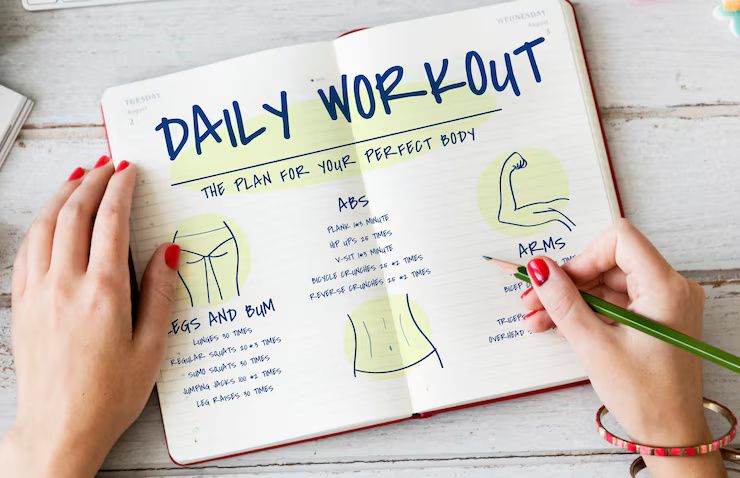Creating a personal fitness plan at home is an effective way to stay healthy, improve strength, boost energy, and achieve long-term wellness—without needing a gym membership. Whether you're a beginner or returning to fitness after a break, a home-based routine can be just as effective as one in a gym when designed with intention.
This guide walks you through the steps to build a personalized workout plan that fits your space, time, and goals.
Why home fitness planning matters today
With busy schedules, limited access to gyms, and the rising importance of health awareness post-pandemic, more people are choosing home workouts for convenience and flexibility. A personal fitness plan ensures:
-
Structure and consistency in workouts
-
Faster and safer progress toward fitness goals
-
Motivation and reduced risk of burnout
-
Better use of time and home resources
Regardless of your experience level, having a plan keeps you focused and helps track your results over time.

Key elements of a home fitness plan
Your personal fitness plan should include a balance of the following components:
| Component | Purpose | Examples |
|---|---|---|
| Warm-up | Prepares muscles, increases heart rate | Jumping jacks, arm circles, light jog |
| Cardio | Burns calories, strengthens the heart | High knees, jump rope, brisk walking |
| Strength training | Builds muscle, boosts metabolism | Squats, push-ups, resistance bands |
| Flexibility | Improves mobility, reduces injury risk | Yoga, stretching, foam rolling |
| Cool down | Lowers heart rate, aids recovery | Gentle walking, deep breathing, stretches |
Step-by-step guide to building your plan
1. Set clear fitness goals
Identify what you want to achieve. Your goals might include:
-
Weight loss
-
Muscle gain
-
Improved flexibility
-
Stress relief
-
Increased energy
2. Choose your workout days
Be realistic. Start with 3–4 days a week and gradually increase. Example:
-
Monday: Cardio + Strength (Upper Body)
-
Wednesday: Yoga or Core
-
Friday: Cardio + Strength (Lower Body)
-
Sunday: Flexibility & Recovery
3. Select your training space and equipment
You don't need much space—a yoga mat area is enough. Basic home fitness tools:
-
Resistance bands
-
Dumbbells or water bottles
-
Jump rope
-
Yoga mat
-
Chair or step
4. Plan your workouts by category
Each workout should last 20–45 minutes depending on your schedule and level.
| Workout Type | Duration | Sample Activities |
|---|---|---|
| Cardio | 15–30 mins | Jump rope, jogging in place, dancing |
| Strength | 20–30 mins | Bodyweight squats, lunges, planks |
| Flexibility | 10–15 mins | Sun salutations, hamstring stretches |
Keep a simple log or use fitness apps to monitor:
-
Number of sessions/week
-
Sets, reps, and rest times
-
Body measurements or photos
-
How you feel after workouts
Tools and resources to help you stay on track
| Tool/App | Purpose |
|---|---|
| Nike Training Club | Free home workouts for all levels |
| FitOn | Guided video workouts with expert trainers |
| MyFitnessPal | Calorie tracking and progress logging |
| Google Sheets | Customizable workout planner |
| YouTube Channels | Home-friendly workouts (e.g., Chloe Ting, Pamela Reif) |
Tips for sticking to your plan
-
Set a fixed workout time each day
-
Use music or a podcast to stay engaged
-
Start small—10–15 minutes is enough to begin
-
Track wins: Did you do more reps this week? Celebrate it!
-
Stay flexible—missed a day? Just adjust, don’t quit
Common mistakes to avoid
-
Doing only cardio or only strength—balance is key
-
Skipping warm-ups or cool-downs
-
Ignoring rest days—recovery is part of progress
-
Pushing too hard too soon—build gradually
-
Comparing your progress with others—focus on your journey
Sample weekly workout schedule
| Day | Focus | Activity |
|---|---|---|
| Monday | Full-Body Strength + Cardio | 20 min bodyweight circuit + 10 min jump rope |
| Tuesday | Active Recovery | Light yoga and stretching |
| Wednesday | Lower Body Strength | Squats, lunges, glute bridges |
| Thursday | Cardio | HIIT workout or brisk walking |
| Friday | Core & Flexibility | Planks, crunches, gentle stretching |
| Saturday | Rest or optional activity | Leisure walk or stretching |
| Sunday | Upper Body Strength | Push-ups, rows, shoulder taps |
FAQs
1. Can I lose weight with home workouts?
Yes. Combined with proper nutrition, consistent home workouts can support weight loss. Focus on both cardio and strength training.
2. How long should each workout session be?
Start with 20–30 minutes per session. As you build endurance and strength, you can extend to 45–60 minutes.
3. Do I need special equipment to start?
Not at all. Many effective workouts use only body weight. If you want to add equipment, start with a resistance band or a pair of dumbbells.
4. How soon will I see results?
Most people feel stronger and more energetic within 2–4 weeks. Visible changes typically appear after consistent training for 6–8 weeks.
5. Is it okay to work out every day?
Yes, but alternate workout intensity. Mix active recovery (like yoga) with higher-intensity sessions. Rest days are important for muscle recovery.
Final thoughts
Building a personal fitness plan at home empowers you to take control of your health—on your own terms. With just a little space, a few tools, and consistency, you can create a routine that fits your lifestyle, energizes your body, and supports your well-being.
